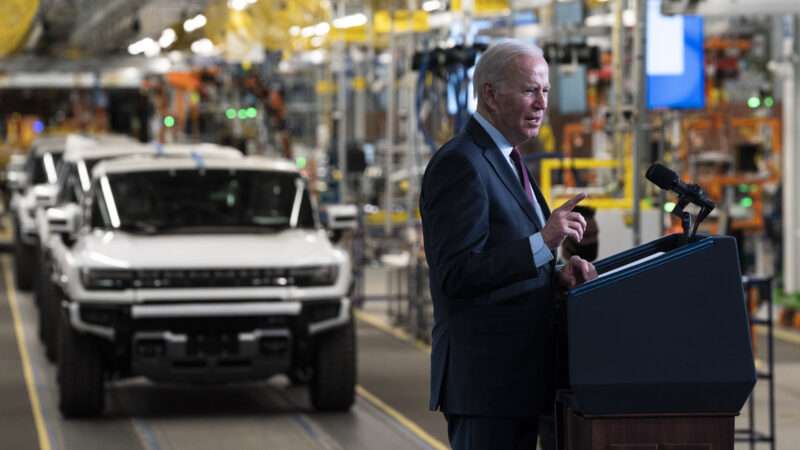
This week, the Environmental Protection Agency (EPA) announced new vehicle standards with updated limits on car and truck emissions. If adopted, the rules would include prioritizing electric vehicles (E.V.s) and mitigating climate change. While those are good goals, it's not clear if the auto industry will be able to pull them off on the government's timeline.
More to the point, while it's entirely inappropriate for the government to make such mandates, it also may hinder future progress on E.V. technology.
President Joe Biden has been pushing for an E.V. future. In August 2021, he signed an executive order advocating that by 2030, half of all new vehicles sold in the U.S. should be electric. At the time, the nation's "Big Three" automakers—General Motors, Ford, and Stellantis—agreed, jointly announcing a "shared aspiration" that by 2030, "40-50%" of their U.S. vehicles would be hybrid or all-electric "in order to move the nation closer to a zero-emissions future." To that end, the global automotive industry expects to spend $1.2 trillion by the end of the decade.
The EPA's new rules go even further. Some pertaining to light-duty vehicles (cars and trucks weighing under 10,000 pounds) would require as many as 60 percent of new cars and trucks to be E.V.s by 2030, jumping to 67 percent by 2032. If adopted, they would make mandatory what Biden's 2021 executive order had merely recommended.
The EPA estimates that adopting all of its rules "would avoid nearly 10 billion tons" of carbon emissions and "reduce oil imports by approximately 20 billion barrels" through 2055. But the auto industry may not be able to meet these accelerated deadlines, and it could even disincentivize innovation in the field.
In 2022, E.V.s made up 5.6 percent of U.S. auto sales, more than tripling their market share in three years. The sector is certainly booming—new E.V. registrations rose 60 percent in early 2022 even as overall new car registrations fell by 18 percent—but going from less than 6 percent of the market to fully two-thirds in less than a decade is quite ambitious.
Not to mention, despite falling prices in recent months, E.V.s remain considerably more expensive than their internal-combustion counterparts. In September 2022, the average E.V. cost $17,000 more than the average gas burner, according to Kelley Blue Book. Rep. Debbie Dingell (D–Mich.), whose district sits near the U.S. auto capital of Detroit, told Politico, "I'm hearing from too many people in this country—I mean, strong Democrats—that they can't afford an electric vehicle."
The Biden administration tried to put its thumb on the scale by including tax credits of up to $7,500 for E.V. purchases in last year's Inflation Reduction Act (IRA), but those credits are directly dependent on whether the battery's materials were sourced from a U.S. trade ally or a "foreign entity of concern." The latter clause was clearly directed at China—which is unfortunate, since that country owns or controls the vast majority of minerals used in E.V. batteries.
Overall, the E.V. industry is struggling to reach scale. Ford, which sells more E.V.s than any company except Tesla, lost $2.1 billion on its electric division last year and expects to lose another $3 billion this year. Rivian, an electric truck and SUV manufacturer with one of the most successful IPOs in recent history, is struggling to meet its own production targets as it burns through cash. At this rate, there's no guarantee that the automotive industry will be able to reach the government's target of 67 percent E.V.s by 2032.
The Biden administration should let the market decide. Clearly, there is a demand for electric vehicles. But by insisting on the rate at which the industry needs to make the transition, the administration's incentives could be undermining progress. Axios noted this week that "battery technology is still evolving…meaning the U.S. may be at risk of building mines and factories to produce batteries that wind up being obsolete in a decade."
As Reason's Ronald Bailey wrote in the March 2023 issue, electrochemists are already devising new methods of powering electric cars that don't use scarce materials. By imposing such a breakneck timeline, the EPA is forcing automakers to choose production over innovation.
The post The EPA's Ban of Gasoline-Powered Cars Will Actually Slow Development of Electric Cars appeared first on Reason.com.







